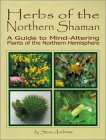

|
The Shamanic Tradition Modern Shamans Reference Works |
| Modern Shamans
Aldous Huxley - Its widely known that Huxley experimented with
psychedelics including mescaline and LSD. In fact he died tripping
on acid (intentionally). His great works of fiction include Brave New World
about test-tube babies, consumerism and Soma, the drug of choice.
Timothy Leary - The high priest of LSD, Leary is clearly the King of Shamans. His role as professor at Harvard University soon took a back seat to his public persona once he discovered for himself the powerful insights available through psychedelics. Unable to restrain his enthusiasm, Harvard dismissed him, allowing Leary to experiment with psychedelics under his own terms. Once freed of clinical restraints, Leary determined which factors enhanced and promoted "good trips". Leary was quick to realize that the LSD trip was a religious experience that transformed the tripper for life. He encouraged clergy, scientists, artists and many others to experiment with LSD and recorded their experiences. His legendary sessions in Millbrook, N.Y. yielded much data, but more importantly pioneered the personal and interpersonal psychedelic experience as never before. Leary became the focus of public and private debate about the use of
drugs, leading to the criminalization of LSD and other psychedelics.
Leary himself became the target of governmental repression, with Richard
Nixon calling him "the most dangerous man in America". Imprisoned,
escaped, on-the-lam, returned from exile, Leary remained unfazed in his
efforts to promote the psychedelic, shamanic experience. His numerous
books exhort the reader to discover for himself the mind expanding potential
of psychedelics.
John Lennon - While John Lennon might have considered himself
foremost an artist and musician, he nevertheless met the criteria of a
shaman in today's society. His great influence among young people
was due to his expressive nature. His experiences with psychedelics,
particularly LSD, changed his view of the world and the way he expressed
himself through his music. Not only did he become more experimental
and inventive, but his lyrics took on an otherworldly nature. His
songs inspired countless thousands to open their minds and experiment with
psychedelics. Some of his tunes were actually composed and recorded
under the influence of LSD. John was a tireless promoter of the shamanic
message of peace, love and understanding. His message reached the
far corners of the planet.
Carlos Castaneda - Steeped in the shamanic tradition of the Nahuatl
indians of Mexico, Castaneda weaves a tale of initiation, revelation, power
and transcendence in his series of books. The story of how Carlos
meets and accepts his apprenticeship under the tutelage of brujo Don Juan
is a masterpiece. The endless debate about whether it's a work of
fact or fiction is notwithstanding. The teachings underlying the work have
great merit, as they give meaning to existence and provide a path, the
warrior's, for those souls brave enough to confront their own weaknesses
and transform themselves.
Terence McKenna -
At the time of this writing, Terence McKenna lies in a hospital bed awaiting
his final destiny. He is a man who, like Gordon Wasson, lived with
the natives and learned their shamanistic ways. Along with his brother,
they added much to our knowledge of ethnobotany, the native uses of psychedelic
plants. McKenna's book, Food of the Gods, was a landmark in this
field.
Jim Morrison - Jim was an iconoclast who used his fame to get
his message across. A poet and philosopher, Jim felt it necessary
to push the envelope and society as far as you could to find freedom.
He knew that drugs were just "Doors" to other worlds where few explorers
ventured. His music, his lyrics and his passion took us to some dark places
in our personal and collective psyches. Like any good shaman, Jim's
real talent was taking us along on his journeys into these forbidden realms
and opening our minds with his vivid perceptions.
Alexander & Ann Shulgin - This husband and wife team have
explored the whole range of psychedelic drugs including some that few if
any have tried. They are known as the parents of Ecstacy.
Ken Kesey - In contrast to Timothy Leary's experimental approach
to psychedelics, Kesey explored the experiential. Along with his
Merry Pranksters, Kesey felt that psychedelics were a new way to experience
the world. Inviting diverse friends from Allen Ginsberg to the Hell's
Angels to his place in La Honda he was able to transform groups of people
via the communal "trip". After turning on hundreds, he decided to
take his show on the road in a day-glo bus. Kesey and the Pranksters
went on a psychedelic cross country "trip" that inspired many including
the Beatles (Magical Mystery Tour) to try to duplicate. The famous
Acid-Test parties where LSD laced Kool-Aid was dispensed accompanied by
music (by such notables as the Grateful Dead) and light shows were modern
day correlates to the shamanic rituals of old.
|
| Reference
Works
In addition to the books mentioned above, here are some books that delve into psychedelics and shamanism.
|
 Herbs
of the Northern Shaman, A Guide to Mind Altering Plants of the Northern
Hemisphere by Steve
Andrews. Andrews describes in
clear, understandable terms the plants, their active constituents, the
dosages, and their effects on the human mind and body. Many photos and
illustrations are included. You will find information on the expected plants
such as Cannabis, Datura, and Peyote as well as the unexpected effects
of such common garden favorites as Buttercup, Sassafras and Water Lily.
Herbs
of the Northern Shaman, A Guide to Mind Altering Plants of the Northern
Hemisphere by Steve
Andrews. Andrews describes in
clear, understandable terms the plants, their active constituents, the
dosages, and their effects on the human mind and body. Many photos and
illustrations are included. You will find information on the expected plants
such as Cannabis, Datura, and Peyote as well as the unexpected effects
of such common garden favorites as Buttercup, Sassafras and Water Lily. |